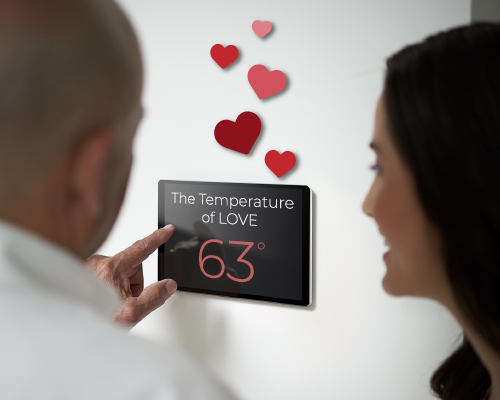
February 2023
Read Time: 4 minutes
Valentine’s Day is all about love, romance, and finding that special someone to snuggle up with. However, for many couples, there’s one major problem that can put a damper on the mood: the thermostat. This age-old battle is no secret. It seems nearly impossible for men and women to find common ground when setting the thermostat.
Vivint Solar reports that 75% of Americans argue over the thermostat and 60% of people get angry when someone messes with their thermostat. However, 64% of that same group reported that they change the thermostat anyway even if they know it will make their partner mad. Have you ever wondered why men and women seem to disagree on the ideal temperature?
The Science Behind Thermostat Wars
The answer lies in our genetics and biology. One of the most significant reasons can be linked to the metabolic differences between men and women. Men generally have a faster metabolism, which means they feel warmer and more comfortable in cooler temperatures.
Women, on the other hand, have a slower metabolism, meaning they feel more comfortable in warmer temperatures. Nate Adams, founder of Energy Smart Home Performance, explains “in general, men have much faster metabolisms than women by about 30 percent”.
Women Store More Heat at their Core Compared to Men
According to W.L. Gore scientists, women have a more evenly distributed fat layer which helps them retain warmth in their core organs. This is why women, on average, have a higher core temperature than men. Their bodies are also more effective at retaining heat than male bodies. I know what you might be thinking – if women are better at retaining heat then why do they seem cold more often?
The same factor that allows women to retain warmth in their core can also make them more sensitive to cold. The process of retaining warmth in the core causes the blood flow to be concentrated there, leaving less warmth for a woman’s extremities. As a result, a woman’s hands and feet may drop in temperature, making them feel cold immediately. This is why women may often feel colder than men, despite having a higher core temperature.
A University of Utah study found that women’s core body temperatures can actually run 0.4 degrees F higher than men’s on average. And women’s hands can be significantly colder — 82.7 degrees F on average, compared with 90 degrees F for men.
The Temperature of Love

If you are hoping to get your partner to cuddle up and watch a romantic movie this Valentine’s Day, recent social experiments suggest there is an inverse relationship between temperature and our preference for romantic movies. That is, when temperatures decrease, our preference for romantic movies increases!
When our bodies are exposed to lower temperatures, we naturally want to conserve heat and cuddle up, which creates the perfect atmosphere for a romantic film. We associate romantic movies with physical warmth, and this is why we crave them when we’re cold.
So, this Valentine’s Day, instead of fighting over the thermostat, why not embrace the science behind temperature and mood? Try lowering the thermostat to 62-67 degrees. This will set the stage for some Valentine’s Day snuggles and increase everyone’s preference for romantic movies!
Want to read more blog posts from Kettle Moraine Heating & AC?





